Description
provided by Zookeys
Gnathosoma. Pedipalps 5-segmented and reach beyond the subcapitulum by at most the distal half of the last segment. Simple setae present on the basi- and telofemora. Pedipalp tibiotarsi long and S-shaped (as opposed to short and cylindrical as in Neoscirula). Subcapitulum with 4 pairs of setae (hg1–4). 2 pairs of adoral setae present. Chelicera with seta usually present. Extensive reticulated pattern absent from the gnathosoma, though a row of single cells may be present caudally.
Idiosoma, dorsal. Plates lightly sclerotized and may not be well defined or demarcated. Proterosomal plate bears 2 pairs of setae (lps and mps) and 2 pairs of setose sensillae (at and pt). Extensive reticulated pattern absent, although a pair of rows of up to 6 cells may be present. Proterosomal plate may be covered with random dots or papillae. Hysterosomal plate absent. Setae c1–h1, and usually c2 and f2 present dorsally; h2 present or absent. Cupules im present laterad and sometimes caudally of e1. Integument striated.
Idiosoma, ventral. Coxae usually restricted to the trochantral bases, though sometimes coxae I–II may nearly touch medially. Coxae I–II fused. Coxae III–IV fused. All coxae lightly sclerotized and may be ill-defined. Extensive reticulated pattern absent from the coxae, though a row of cells or reticulated pattern may be present near the edges. Coxae may be covered with random dots or papillae. Coxae I–IV usually have the simple setal formula 3-3-3-3 (Neobonzia parilis is the exception with 2-2-3-2). Genital plates each bear 3–4 setae; 2 pairs of genital papillae visible underneath the plates. 2 pairs of setae (ps1–2) usually occur on the anal plates and 1 pair of setae (pa) occurs on the integument near the anal plates. However, at least one species (Neobonzia clavata) has 3 pairs of setae present on the anal plates and 0 pairs of setae on the integument. Cupules ih present ventrally near the anal plates. Legs. Tarsi never constricted apically so as to end in lobes. The apices of solenidia cylindrical, not swollen as in Coleoscirus and Scutascirus. Trichobothrium on leg tibia IV present. Ambulacral claws rippled and occur on either side of a 4-rayed empodium.
- license
- cc-by-3.0
- copyright
- Michael J. Skvarla, J. Ray Fisher, Ashley P. G. Dowling
- bibliographic citation
- Skvarla M, Fisher J, Dowling A (2014) A review of Cunaxidae (Acariformes, Trombidiformes): Histories and diagnoses of subfamilies and genera, keys to world species, and some new locality records ZooKeys 418: 1–103
- author
- Michael J. Skvarla
- author
- J. Ray Fisher
- author
- Ashley P. G. Dowling

